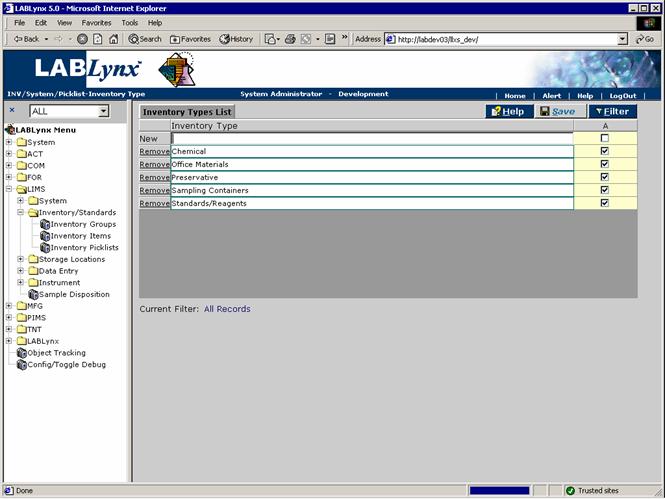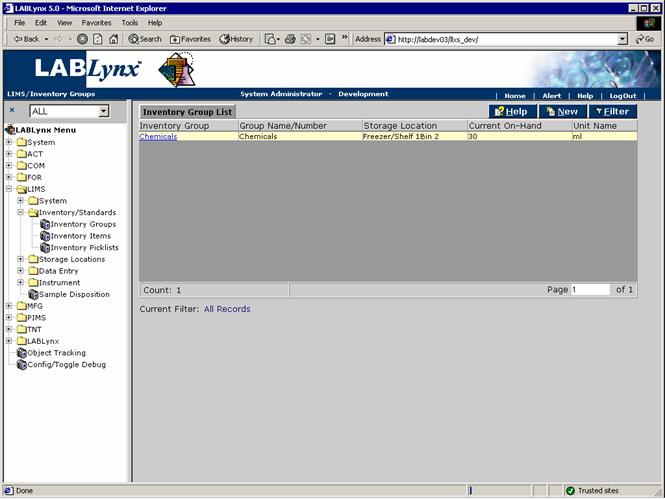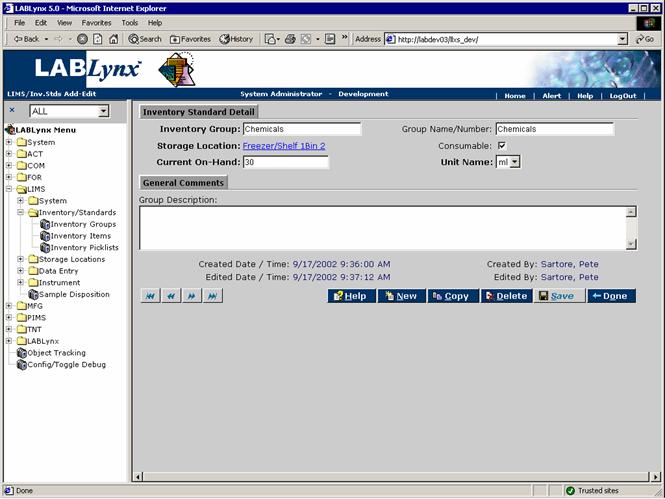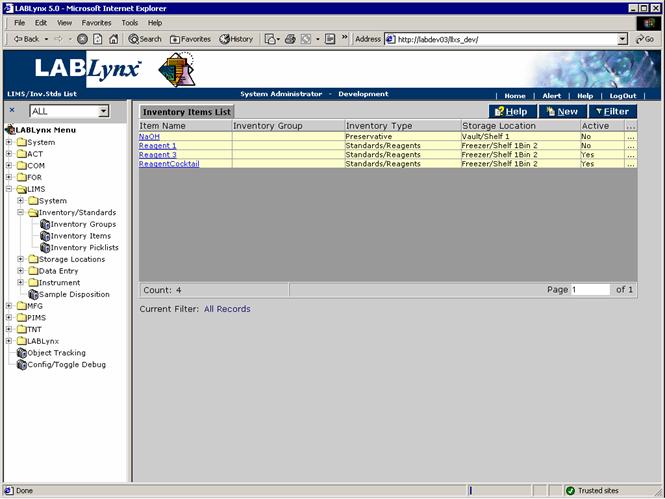LabLynx KB:Peripheral module - 1.0 inventory
|
|
This is an article specific to the Category:LabLynx knowledge base. Its context outside of LabLynx, Inc may not be apparent, thus why it appears inside the LabLynx KB namespace. |
Introduction
The purpose for inventory/standards management is two fold. The primary use for the items is for association with specific process batches in the LIMS Results Entry area. This allows users to associate batches of processed sample with the reagents, standards, and other materials used in their processing. The second use for the inventory/standards management area is to allow the laboratory to track the items consumed and in-use by the laboratory for general information purposes.
Storage location
A storage location is exactly as it sounds — it is a storage location definition that is specific to a system location (many can be defined for a single location). The storage locations are used by many modules within LabLynx, primarily the Inventory/Chemical and Sample storage areas.
The purpose for a storage location is for locating inventory items and samples throughout the laboratory. The storage location definitions are key entities for the optional object tracking module as samples and inventory items are logged into and out of these storage locations for custody purposes.
The user is displayed a list of currently defined storage locations in the Storage Locations List. To the far right on the screen exists …, indicating that additional information exists for the values. The information displayed to the user is as follows: the location Name from the central system location list, the storage location name, room name/number, and storage categorization type (this value is system level):
The user may edit an existing record simply by clicking the selected record, redirecting the user to the Storage Location Details screen. The user may also create a new record in this list by selecting the New button, which will also redirect to the Storage Location Details screen.
On this screen the user will see the specific details associated with a selected storage location or the required information to enter for a new storage location. The system location, location name, and storage location type are required fields. Once a storage location is created, two additional areas below the details will become exposed.
The Storage Location Labs area is for department assignments, which is an indicator that the storage location is shared amongst multiple location/department combinations. The Storage Location Components area describes sub-storage locations, generally thought of as shelving units, bins, and/or other storage units within the current storage location:
Special Notes: Modifying an existing storage location can adversely affect samples and inventory items previously associated with a selected storage location. Modifications to existing records in this area must be done only by qualified system administrators.
Inventory type picklist
The inventory type picklist is a central list of inventory types that are in use by the system at the inventory item level. The inventory type picklist allows for one central area where inventory types may be defined and then assigned at the inventory item level. Inventory yypes are defined and assigned to actual inventory items for the purposes of simplifying inventory item location in that section through the use of the filter and sort functions. The user is shown a list of currently defined inventory type names and status values from the Inventory Pick Lists List:
The user may edit an existing record simply by clicking the selected record, making changes, and selecting the Save button to commit the changes. The user may also create a new record in this picklist by entering in the new information into the first row and selecting the Save button:
Special Notes: Editing an existing record will cause all other areas of the system that capture information from this picklist type to reflect the changed value.
Inventory groups
Inventory Groups should be thought of as general inventory types where the overall tracking of quantity can take place. Once an inventory group is created, inventory items may be defined for that group. Each Item is a specific sub-group for that inventory group. The next example illustrates the relationship that exists between inventory groups and inventory items.
The purpose of inventory groups is to track total quantity on hand for a general category or group, which consists of multiple inventory items. Additionally, it provides the laboratory with the ability to create a parent group or entity under which the actual inventory items may be tracked.
For example, a typical inventory group that laboratories use may be "Latex Gloves". Under the general inventory group of "Latex Gloves" new shipments are delivered or purchased by the laboratory on an as-needed basis. When the group is initially created, 100 boxes of gloves exist in the lab (the starting on-hand amount). As new shipments are received they may be logged into the inventory items area where the specific information may be stored such as vendor, lot number, etc. The action of adding a new inventory item and assigning it to the "Latex Gloves" group may cause the system to automatically update the amount on hand for the group. Similarly, as the items are consumed the amount on hand will drop accordingly.
From the Inventory Group List the user is shown a list of currently defined inventory groups in the system. The user is displayed all inventory groups regardless of location:
The Inventory Standard Detail screen is shown to a user who selects an existing inventory group or presses the New button. The user has the ability to define the general name, description, storage location, amount/units of measure on hand, and whether or not the group is consumable:
Special Notes: The Consumable flag must be selected if the user wishes to have the system track the amount on-hand, based on the inventory items.
Inventory items
Inventory Items are the individual items that require tracking in the system. These may be laboratory chemicals and reagents, gloves, reference materials, etc. Each inventory item can be given a system-assigned trace ID in order to track the custody of that item (provided the optional object tracking module is in use).
The purpose for inventory items is two fold. First, an association is created with specific process batches in the LIMS Results Entry area. This allows users to associate batches of processed sample with the reagents, standards, and other materials used in their processing. The second use for the inventory items area is to allow the laboratory to track the items consumed and in-use by the laboratory for general information purposes.
A typical inventory item would be a reagent used during a routine chemical analysis. This reagent item would likely have expiration information as well as lot number information, and the laboratory wishes to be able to link sample testing results to the specific reagent used for traceability purposes. By creating the item in this section, the user responsible for results entry would be allowed to assign the item to the process batch producing the desired traceability.
From the Inventory Items List the user is shown a list of currently defined inventory items in the system. To the far right on the screen exists …, indicating that additional information exists for the values. The information displayed to the user is as follows: the inventory item name, inventory group reference, Inventory item type, storage location, and whether or not the item is active. The user is shown all inventory items regardless of location and status:
The user will be shown Item Description screen when selecting an existing inventory item or entering a new inventory item using the New button.
There are several required fields that must be defined:
- item name
- inventory type
- storage location
- amount/units on hand
The remaining fields do not require definition. The reason for this is that this area was designed to accommodate many types of different inventory types, from reagents to pencils. Generally, each inventory type may or may not have all of the information that the screen is capable of accepting. This allows for the definition of the inventory item based on the information provided or available. A list will appear at the bottom of the screen called "Inventory Components," either when a predefined item is selected or a new item has been saved. The components of an item are other items defined in this section that make-up the item like the ingredients in a recipe. Under most laboratory circumstances, these components would be reagents used in the making of a new "cocktail" reagent. There is no limit to the number of component items that may be assigned to a specific item:
Special Notes: For inventory items to be used at the process batch section, the item must be non-expired and active.















